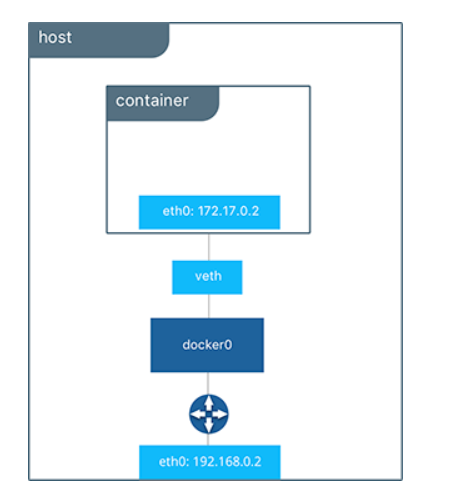Docker Networking
 Sidharth Dash
Sidharth DashIn a VM by default docker has bridge network.
Types of Docker Networks:--
By default docker has three types of networks. Check the hyperlink
Bridge network 2. Host network 3. Overlay 4.ipvlan 5.macvlan 6.none 7 I.P VLAN
bridge: It's a default network mode in docker. It creates a private network between host and container, allowing containers to communicate with each other and with the host operating system. How a container can talk to host i.p address by default is bridge network.

If you want to secure your containers and isolate them from the default bridge network you can also create your own bridge network.
docker network create secure-network ubuntu@ip-172-31-16-65:~$ docker network ls NETWORK ID NAME DRIVER SCOPE f5a47cca3996 bridge bridge local 9a42e01787a9 host host local cda7c54ef44c none null local eead6d2e0a40 secure-network bridge local docker run -d --name --network secure-network finance nginx:latest docker network connect secure-network finance docker ps docker inspect finance docker inspect logout "IPAddress": "172.17.0.4", "IPPrefixLen": 16, "IPv6Gateway": "", "GlobalIPv6Address": "", "GlobalIPv6PrefixLen": 0, "MacAddress": "02:42:ac:11:00:04", "DriverOpts": null }, "secure-network": { "IPAMConfig": {}, "Links": null, "Aliases": [ "47e64f337ad5" ], "NetworkID": "eead6d2e0a40152fa39ca1871625ce3334a90d6c8ee850f6978b9a59e18bdce7", "EndpointID": "900483644ef194fccd77887e5f5afd9829c04e1ea7568343f319b96ca8abe36f", "Gateway": "172.18.0.1", "IPAddress": "172.18.0.2", "IPPrefixLen": 16, "IPv6Gateway": "", "GlobalIPv6Address": "", "GlobalIPv6PrefixLen": 0, "MacAddress": "02:42:ac:12:00:02", "DriverOpts": {} } } } #suppose i want to check whether i can connect to the secure network #from the host network. Then ubuntu@ip-172-31-16-65:~$ docker ps CONTAINER ID IMAGE COMMAND CREATED STATUS PORTS NAMES 47e64f337ad5 nginx:latest "/docker-entrypoint.…" 12 minutes ago Up 12 minutes 80/tcp finance 6aa7c42f20d4 nginx:latest "/docker-entrypoint.…" 27 minutes ago Up 27 minutes 80/tcp logout 0fd7be226650 nginx:latest "/docker-entrypoint.…" 2 hours ago Up 2 hours 80/tcp login ubuntu@ip-172-31-16-65:~$ ubuntu@ip-172-31-16-65:~$ ubuntu@ip-172-31-16-65:~$ docker exec -it 0fd7be226650 /bin/bash root@0fd7be226650:/# root@0fd7be226650:/# ping 172.18.0.2 PING 172.18.0.2 (172.18.0.2) 56(84) bytes of data. ^C --- 172.18.0.2 ping statistics --- 23 packets transmitted, 0 received, 100% packet loss, time 22513ms ##It shows i cannt connect to the secure network from the #host networkHost Network:-
It can directly access the container with the host i.p address itself.
There is no custom i.p address of the host network because it's binded with the host networking. Here both container and host fall under same C.I.D.R block.
This mode allows containers to share the host system's network stack, providing direct access to the host system's network.
To attach a host network to a Docker container, you can use the --network="host" option when running a docker run command. When you use this option, the container has access to the host's network stack, and shares the host's network namespace. This means that the container will use the same IP address and network configuration as the host.
Here's an example of how to run a Docker container with the host network:
docker run --network="host" <image_name>
docker run -d --name host-demo --network=host nginx:latest docker ps docker inspect host-demo
Macvlan Networking
Macvlan networks allow you to assign a MAC address to a container, making it appear as a physical device on your network.
Commands:--
ubuntu@ip-172-31-16-65:~$ history
1 clear
2 sudo apt-get update -y
3 clear
4 docker pull nginx
5 ip address show
6 sudo apt install docker.io
7 clear
8 docker ps
9 sudo usermod -aG docker $USER
10 docker ps
11 sudo usermod -a -G docker $USER
12 docker ps
13 sudo usermod -a -G docker $USER
14 clear
15 docker ps
16 docker pull nginx
17 docker images
18 docker run -d --name login nginx:latest
19 docker exec -itd login /bin/bash
20 docker ps
21 docker exec -it 0fd7be226650 /bin/bash
22 docker images
23 docker run -d --name logout nginx:latest
24 docker ps
25 docker inspect login
26 docker inspect logout
27 docker images
28 docker ps
29 docker exec -it 0fd7be226650 /bin/bash
30 docker network ls
31 docker network create secure-network
32 docker network ls
33 docker run -d --name --network secure-network finance nginx:latest
34 docker run -d --name --network=secure-network finance nginx:latest
35 docker run -d --name finance nginx:latest
36 docker network ls
37 docker ps
38 docker network connect secure-network finance
39 docker ps
40 docker inspect finance
41 docker inspect logout
43 docker exec -it 0fd7be226650 /bin/bash
44 docker ps
docker run -d --name host-demo --network=host nginx:latest
46 docker ps
47 docker inspect host-demo
48 history
Overlay Networking:--
This mode enables communication between containers across multiple Docker host machines, allowing containers to be connected to a single network even when they are running on different hosts. For multi-host networking, typically used with Docker Swarm.
A bridge network is used for communication between containers on the same host, while an overlay network allows containers on different Docker hosts to communicate
docker network create -d overlay my-overlay-network
How do you set a static IP address for a container--
docker run -d --network my-network --ip 192.168.1.100 my-image-name
What are Docker volumes and why are they used?
Docker volumes are used to persist data generated by and used by Docker containers.
Volumes provide a way to store data outside the container's file system, allowing it to be shared among containers and survive container restarts.
Subscribe to my newsletter
Read articles from Sidharth Dash directly inside your inbox. Subscribe to the newsletter, and don't miss out.
Written by

Sidharth Dash
Sidharth Dash
Hello Team, Working Devops Support Engineer having 8.2 years of experience in Unix, Shell Scripting, SQL. Since one year i started my journey as a DevOps support engineer where i am involved in Deployments, Infrastructure monitoring using AWS- cloud-watch, Automating simple task using shell scripts.